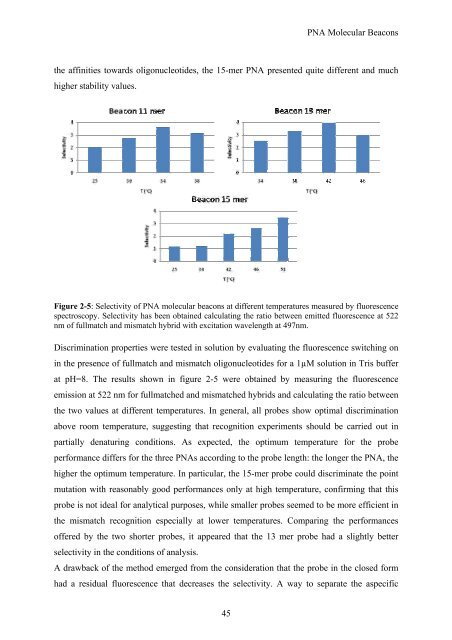View - DSpace UniPR
View - DSpace UniPR
View - DSpace UniPR
You also want an ePaper? Increase the reach of your titles
YUMPU automatically turns print PDFs into web optimized ePapers that Google loves.
PNA Molecular Beacons<br />
the affinities towards oligonucleotides, the 15-mer<br />
higher stability values.<br />
PNA presented quite<br />
different and much<br />
Figure 2-5: Selectivity of PNA molecular beacons at different temperatures measured by fluorescence<br />
spectroscopy. Selectivity has been obtained calculating the ratio between emitted<br />
fluorescence at 522<br />
nm of fullmatch and mismatch hybrid with excitation wavelength at 497nm.<br />
Discrimination properties were tested in solution by<br />
evaluating<br />
the fluorescence switching on<br />
in the presence of fullmatch and mismatch oligonucleotides for<br />
a 1µM solution in Tris buffer<br />
at pH= 8. The results shown<br />
in figure 2-5 were obtained by<br />
measuring the fluorescence<br />
emission at 522 nm<br />
for fullmatched and mismatched<br />
hybrids and calculating the ratio between<br />
the two<br />
values at different temperatures.<br />
In general, all probes<br />
show optimal discrimination<br />
above room temperature, suggesting that recognition experiments should<br />
be carried out in<br />
partially<br />
denaturing conditions. As expected, the optimumm temperature for the probe<br />
performance differs for the three PNAs according to the probe length: the longer the PNA, the<br />
higher the optimumm temperature. In particular, the 15-mer probe could discriminate the point<br />
mutation with reasonably good performances only at high temperature, confirming that this<br />
probe is<br />
not ideal for analytical purposes,<br />
while smaller probes seemed to be more efficient in<br />
the mismatch recognition especially at lower temperatures.<br />
Comparing<br />
the performances<br />
offered by the two<br />
shorter probes, it appeared that the 13 mer probe had a slightly better<br />
selectivity in the conditions of<br />
analysis.<br />
A drawback of the<br />
method emerged from<br />
the consideration that the probe<br />
in the closed form<br />
had a residual fluorescence that decreases the selectivity. A way to separate the aspecific<br />
45
















